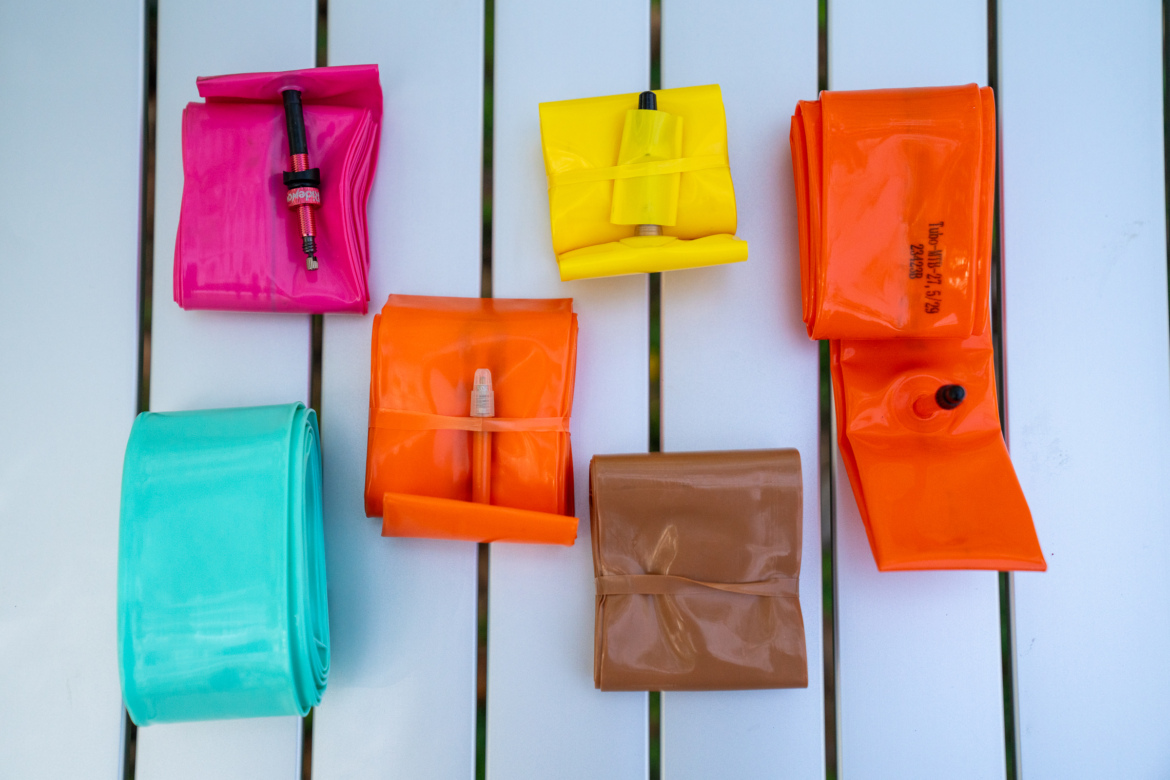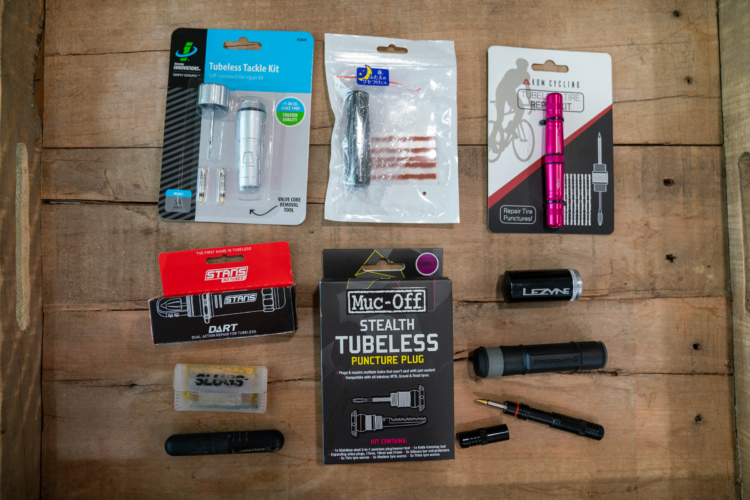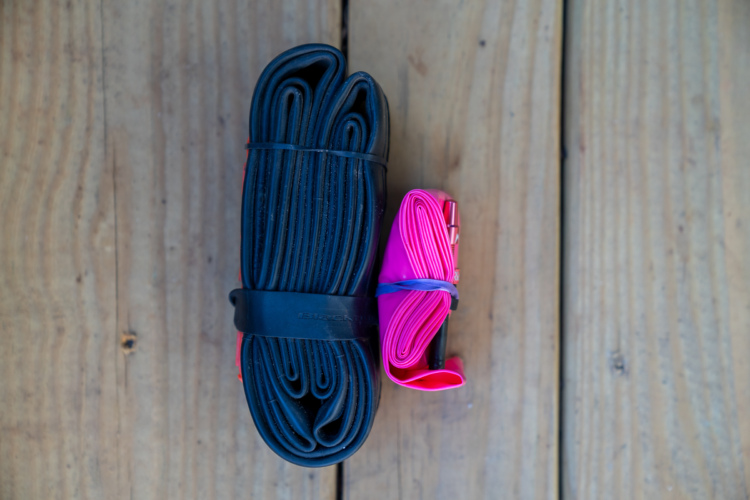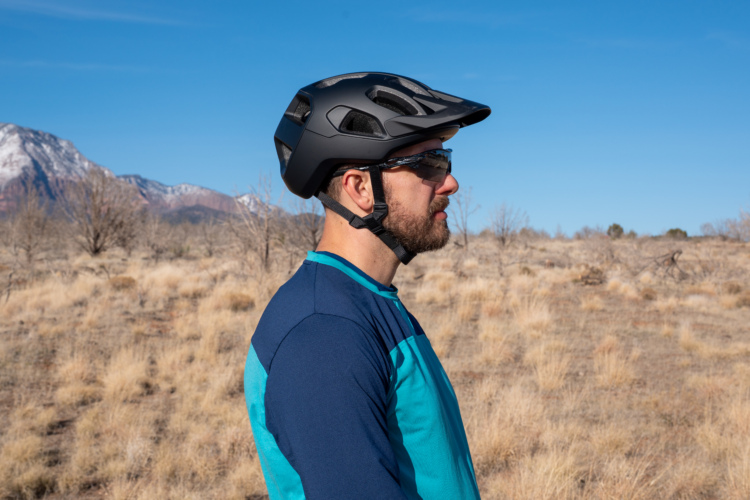
Tubeless tires are the best choice for mountain biking, but in a pinch, a spare tube can serve as a crucial trailside fix. Standard butyl rubber tubes have been the norm pretty much since the earliest days of the pneumatic bicycle tire, but that changed in 2017 when Tubolito marketed one of the first inner tubes made from thermoplastic polyurethane (TPU). TPU tubes are lighter than standard tubes, and in the case of Tubolitos, they’re claimed to be twice as durable, too. The drawback? They’re expensive, priced at more than $30 each, about four times the cost of a standard tube.


Today, Tubolito isn’t the only choice when it comes to TPU. WTB has the NanoAir, and several brands are selling their own TPU tubes on Amazon. With prices as low as $8 per tube, I was curious to find out if the less expensive TPU tubes work as well as the name-brand tubes. I tested four cheap TPU tubes, mounted in the rear tire position, to see how they compare, and here’s what I found. Scroll down for a comparison chart showing all the tubes reviewed.
The tl;dr version is this: While some of the tubes are thicker and work better than others, I’d trust any one of these in an emergency, though none are ideal for long-term use. Tubeless is still the way to go whenever possible.

Tubolito TPU tube
Tubolito is easily the most well-known TPU option, and I’ve been carrying — and occasionally running — these tubes for many years. Compared to the others in this test, the Tubolito appears to be made from the thickest material, and it’s the narrowest overall when folded. It’s also the heaviest tube I tested, but only by a fraction of a gram.
I’ve had good luck using Tubolito tubes for emergency repairs, though I have run into leaks when trying to reuse a tube later. The brand includes a set of patches and alcohol wipes with the tube, though I haven’t tried patching a tube. One thing I’ve always found strange is that Tubolito doesn’t have a threaded valve stem, so there’s no way to secure the valve to the rim like a normal tube with a lock ring.
- Weight: 81.8g
- Price: $32.95 each
- Shop and compare prices

WTB NanoAir TPU tube
The WTB NanoAir launched just last year in a distinctive tan-brown color. On my scale, it weighs 81.6g, almost exactly the same as a Tubolito. However, it’s clearly a different design that’s wider when folded with a thinner feel. WTB includes a patch kit and alcohol wipes with the tube, and there’s a stretchy gasket on the valve stem to help with the seal. Like the Tubolito, the valve stem isn’t threaded, and there’s no lock ring.
Among the TPU tubes I looked at, the WTB NanoAir is the most expensive.
- Weight: 81.6g
- Price: $33.95
- Buy from REI

Thinvik TPU tube
Thinvik TPU tubes are sold in two-packs for about $22, which seems to be the going rate for TPU tubes on Amazon. I put in a 22-mile MTB ride with one, and it held up just fine. For my tests, I started each tube off at 25psi, mounted in the rear on a Yeti SB140 inside a Maxxis Minion DHR II tire with Double Down casing. The day after my 22-mile ride, the Thinvik was still holding about 21psi.
True to their name, the Thinviks feel thinner than most of the others in the test, and weigh about 10g less than the two name-brand tubes above. I like that the valve stem is threaded all the way down for a secure fit to the rim.
Singletracks reader “Bontrager fan 1972” noted he’s tried the Thinkvik tubes and that he “encountered a bad batch of 27.5 Thinvik tubes last month.” He continued, “They failed adjacent to the valve reinforcement zone.” On Amazon, the tubes are averaging a four-star rating out of 100 reviews, and a few of the one-star ratings note tears and leaks at the seam. I saw at least one rider in Pisgah last weekend with a tell-tale yellow tube strapped to his frame, and I personally trust this one to at least get me back to the car in an emergency.
- Weight: 70.8g
- Price: $21.99 for two
- Buy from Amazon

Ridenow TPU tube
The Ridenow TPU tube is the first one I tested. It’s by far the lightest of the bunch at 52.8g, and not surprisingly, it also feels like it’s the thinnest. When I first mounted the tube, I was bummed to find the valve stem threads didn’t reach the rim, at least on the two rims I tried. I actually reached out to the seller to let them know, and they thanked me for the feedback and said they would consider updating the design. They also gave me a $5 refund on the $22 purchase price for two tubes.


The thing is, the Tubolito and WTB tubes don’t feature threaded valve stems at all, and I found the Ridenow tube worked just fine despite the wonky design.
I only rode on this tube for about ten miles, but I rode it hard at Coldwater Mountain, a notoriously rocky trail system. Starting at 25psi, the next day after my ride, the tube had about 18psi left.


Just for fun, I wanted to see what would happen if I overinflated the tire, figuring this would lead to a spectacular bang. To be fair, the Amazon description says, “To prevent irreversible damage, avoid overinflating the inner tube when not installed in the tire.” This is true for all TPU tubes; they’re designed to push against a tire to hold their shape properly and achieve maximum inflation. The same is true for butyl rubber tubes, too.
Despite using an air compressor, the tube never popped on its own, so I popped it with a pick tool.
- Weight: 52.8g
- Price: $21.99 for two
- Buy from Amazon

Cyclami TPU tube
The Cyclami tube is the most likely to be confused with a Tubolito, at least based on the color. However, it’s much wider and thinner than a Tubolito. At $15.99 for two, this is the cheapest option I tested. Cyclami includes patches and alcohol wipes in the box, along with a set of cheap plastic tire levers.
I rode with the Cyclami tube for about seven miles on janky trails that included multiple curb hops. The 25psi starting pressure was down to 18psi when I checked several days later. Like the Thinvik tubes, these get a four-star Amazon rating, but with fewer reviews thus far.
- Weight: 63.7g
- Price: $15.99 for two
- Buy from Amazon

Spingo TPU tube
Of all the TPU tubes I tested, the Spingos look and feel the most similar to the Tubolitos, aside from the color. The weight is almost spot-on, too, though clearly the valve and valve seals are different.
With a thicker material, the Spingo TPU tube needed to be stretched a bit to fit on my 29er rim. And the valve was a tight fit in the rim hole. I failed to record the pressure after my ride, but the tube held its own through a one-hour ride on technical trails.
- Weight: 81.3g
- Price: $21.99 for two
- Buy from Amazon
| Tube | Color | Price each | Size | Weight | Width |
|---|---|---|---|---|---|
| WTB NanoAir | tan | $33.95 | 29 x 1.9-2.5″ | 81.6g | 66mm |
| Tubolito | orange | $32.26 | 27.5″/29″ x 1.8-2.5″ | 81.8g | 49mm |
| Thinvik | yellow | $10.99 | 29”x 1.9-2.6 | 70.8g | 59mm |
| Spingo | blue | $10.99 | 29×2.1-2.5 | 81.3g | 52mm |
| Cyclami | orange | $7.88 | 29×1.9-2.5 | 63.7g | 61mm |
| RideNow | pink | $10.99 | 29″/1.9-2.5 | 52.8g | 58mm |

Conclusion
At the start of this test, I assumed some of these tubes would leak or fail, but now I’m willing to carry any one of these tubes to use in an emergency. All have proven to be up to the job of getting me back to the car without having to limp back on a flat or under-inflated tire.
As far as quality and durability go, the Tubolito tube gets top marks. Yes, it’s heavier and more expensive than the others, but that’s the cost.
I hesitate to highlight any one of these bargain tubes based on my limited tests, and surely we’ll all experience a flat with one or all of these at some point (even the Tubolitos, which I have). However, given the thickness of the Spingo TPU tube, I suspect it’s one of the more durable choices. As with any tube, your mileage may vary.





















13 Comments
3 weeks ago
3 weeks ago
3 weeks ago
3 weeks ago
2 weeks ago
2 weeks ago
2 weeks ago
2 weeks ago
2 weeks ago
2 weeks ago
2 weeks ago
1 week ago
3 weeks ago